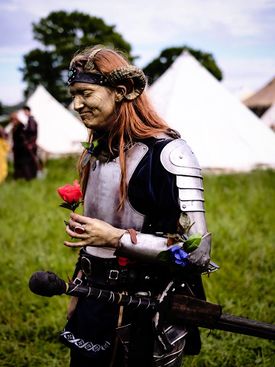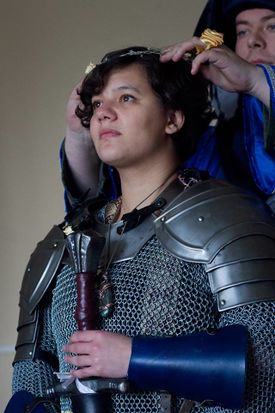Dawn hearth magic
Overview
In the world of Empire, formal magic is the application of learning and willpower to create supernatural effects. There is another form of magic, however which does not require the user to be a magician. Hearth magic employs the innate natural magic of the world to produce subtle but significant effects in much the same way that a compass needle always points true north. The magic is not based on the abilities of a magician, but relies on the innate mystical properties of the world. Hearth magic is usually subtle rather than potent, and where formal magic is predictable and reliable, hearth magic is none of these things.
While the principles that underlie hearth magic are common throughout the world, in Dawn there are certain specific practices, customs, or traditions that draw on the power of the world's innate magic. Often these proud customs are nothing more than traditions - but sometimes their practice taps into some facet of the world resulting in a truly magical effect.
You can learn more about hearth magic, what it is and how it works, here.
Favours
When worn openly a favour serves as a talisman to ward off misfortune and may bring triumph or glory. A common favour is a strip of cloth which has been embroidered or painted by the donor, often with something that symbolises the noble or their house, but they can take any form with Flowers especially popular. A common practice with a favour is to include its presentation as part of a girding ceremony - the favour is usually the last piece of equipment attached during the ceremony. Likewise, ritual magic in Dawn that creates a personal enchantment is often reinforced by the presentation of a favour from the ritualists to the targets.
It pays to be judicious when accepting or wearing a favour. There are cautionary tales of Dawnish folk who suffered ruin when a favour they carried was stolen or secretly swapped for another. Likewise, favours are not guaranteed to protect the bearer. There are ignominious stories of knights slain while undergoing a test of ardour because of a favour gifted by someone who secretly loathed them. Such favours may even carry powerful curses, or simply fail to protect the knight at a crucial moment.
Favours in Play
Although a favour can be a beautiful work of art, it doesn't have to be. Something as simple as a ribbon with a flower pinned to it can serve as a favour - especially given the associations in Dawn between flowers and love. Using a favour in play can be as simple as preparing a suitable item and presenting it to someone with appropriate in-character ceremony. The actual presentation is more important than the favour itself, it is an excellent opportunity for iconic Dawnish interactions.
Trying to win someone's favour can lead to many dramatic scenes, but they can also be offered by political rivals to breed competition or suspicion. If you spot that a Dawnish character is wearing a favour, enquiring after its provenance encourages the other player to share the story with you - or to be creative if they have a reason not to tell you who the favour came from. There are plenty of opportunities for drama when publicly wearing a favour from an unexpected source, or one with unfortunate political implications. When recounting stories, it can be fun to assign any success or good fortune to the influence of a favour.
It's great to use favours in any ritual magic used by Dawnish magicians to create an enchantment - or a curse. Rather than use a more traditional favour, a coven might create strips of cloth marked with a magical symbol such as one of the realm magic sigils developed by Dawnish enchanters to use as magical tools in their rituals. This makes them distinct from common favours which represent a close bond between individuals, and highlights that they are used as anchors for magical effects.
If you want to roleplay that you are giving someone a favour that is laced with loathing or contempt, then that's best done by taking an out-of-character opportunity to let them know. It's always up to the recipient to choose how their character suffers from accepting a malignant favour (hearth magic is never a reliable way to cause trouble for another character after all).
Girding
Traditionally, girding refers to donning armour and readying weapons before a battle, but in Dawn it is used to describe preparing for a challenge by formally dressing oneself in appropriate garb. It is usually done with the assistance of friends and trusted companions and is a way to take on a glorious persona. A magician may take on the qualities of a glorious war-witch by girding themselves with mage armour, rod and shield. Likewise, a senator or archmage might gird themselves with fine robes, documents and a short dagger before addressing the Senate or the Conclave to create a powerful persona that enhances their oratory. The magic of girding also affects any coven of guisers preparing for a play by donning costumes to assume the qualities of the dramaturgical personae.
There are stories of people who gain another's strength by girding themselves with that person's accoutrements. In some tales they may be mistaken for the person whose appearance they take on, if they have gone so far as to employ a disguise or display that person's heraldry. There are cautionary tales in which a villain masquerades as the hero to bring ruin down on their head after they carelessly left their panoply to be stolen by her foe.
Girding in Play
Girding is about making a performance out of getting dressed in readiness for a challenge. A group going into a dangerous situation might gird each other, taking the opportunity to reaffirm their connections to each other. Girding is also a good opportunity to demonstrate the connection between a noble and the yeofolk who attend them, building on the complex social roles within Dawnish society.
Girding gives you the perfect justification to change how you roleplay your character. If you want to psych yourself up for an important encounter of any kind, girding can be the perfect way to do that, both in-character and out-of-character. Your character might ordinarily be a calm and quiet individual but become a proud and defiant speaker or a resolute warrior when suitably girded. If you can manage it, girding can allow you to switch between two completely different characterisations, like having a super hero identity and a mundane alter ego.
If you're aware that someone has girded themselves it can be fun to lean into the roleplaying and act as if that person has changed in some way. Treating someone differently, or not recognising them at all, because they have donned a helm with a faceplate and the surcote of a knight errant can add to the drama of the situation, and help to make the Empire world more real for everyone involved.
Heraldry
Each noble house has its own unique heraldry - and wearing that symbol provides members with a common strength that can be equally empowering on the battlefield and in politics. Shared heraldry can make it easier for members of a house to work together - which can be crucial given the competitive nature of Dawnish society. Individual nobles often develop their own personal heraldry, perhaps even incorporating it into their house coat of arms as a way of emphasising their own accomplishments, or to give themselves lofty ambitions to aim for.

The symbols used in heraldry are crucial and usually involve the use of legendary beasts in the designs. These powerful creatures are known to represent glorious ideals and carrying a shield, a surcote, or similar emblazoned with their image allows a noble to draw on those strengths. Many of these beasts have commonly understood qualities which serve as the basis for heraldic magic; a Dawnish house will often use a beast that exemplifies one or more of the traits that their members aspire to.
Like all yeofolk Knights-errant require explicit permission to carry a house's heraldry, but the majestic royal blue-and-gold-sun national banner is available to all. This device may also be used by a noble who wishes to conceal their identity or house affiliation. The sun has associations with indomitable strength, nobility, competition, and ambition. Dawnish folk who raise the banner aloft do so hoping that the glorious power of the sun will infuse them.
Dawnish nobles and knights-errant will sometimes echo the black knights who fought against Empress Richilde in her tourney to claim the mantle of Queen of Dawn. They obscure their heraldry with black cloth and cover their faces to hide their identity. The hearth magic of heraldry makes it harder for people to recognise anyone who adopts the identity of the "black knight" in this fashion. There is a potential downside; the black knight's heraldry replaces any that the noble is wearing and makes it harder for them to work with people who aren't also black knights. The concealment it brings can be useful in other ways though - especially in dealings with eternals many of whom appear unable to penetrate such a disguise.
Heraldry in Play
When designing the heraldry for your character or your noble house, it is a good idea to look at the associations of magical and legendary beasts detailed in heraldic magic. Selecting one of the beasts listed creates a starting point for communicating something about the nature of your group or character. You can strive to embody those qualities in your roleplaying when wearing your heraldry - especially if you have been girded. You can add nuance to these qualities by using colours, or by showing the animal in one pose or another. A Pegasus with their wings furled and head bowed communicates a very different flavour to one rearing with wings spread; likewise a red-and-gold colour scheme may suggest a more passionate house or individual that the same image in silver-and-blue.
While you don't need to memorise the heraldic beasts, it is worth bearing in mind that the designs people have chosen for their heraldry are telling you something about them or their house. Roleplaying suspicion of a character who adopts a minotaur or chimera is entirely appropriate, even to the point of intentionally casting their deeds in a certain light when talking about them. If that character is also playing up to the idea of their heraldic beast, the entire setting can be brought to life in a nuanced way by players cooperating a little out of character. It can also be fun to play up the idea that a black knight is difficult to identify. The heroic stories in which someone is unrecognisable because they have covered their heraldry and face may seem foolish but in Empire this can be a magical consequence of donning a disguise of this nature.
Love and Flowers
True love is a powerful force, whether romantic, platonic, or filial. Dawnish tales talk of lovers or shades who return from death for a short time to offer comfort, to protect their loved ones, or to urge them to seek vengeance on their behalf. Love is believed to be the one force that can bind souls together in the Labyrinth, and bonds of love may mean that two souls are reborn and driven to seek one another out through multiple incarnations.
Flowers are used as a symbol of love, and are often given as favours. While every house has their own codes of what flowers mean yellow flowers - especially roses - are commonly used as a representation of affection and respect devoid of romantic feelings. Golden flowers are a common element of jewellery given as a gift to a very close friend. In some cases, a Dawnish suitor will present the object of their affection with a flower representing their feelings. If those feelings are not reciprocated, a traditional way to show this is responding with a gift of yellow flowers - yeomen in particular favour a poesy of buttercups to express fondness without passionate love. During the Night of Flowers flowers are given as gifts to strengthen feelings of love, respect, hatred, filial affection, and other emotional ties.
The hearth magic of love can bind people together but it can prove dangerous if betrayed. People whose love proves false may bring a curse on their head. The most common such curse is a malady that causes the betrayer to feel painful burns and welts whenever flower petals touch their skin. People whose love is betrayed sometimes learn of that treachery through symbolic visions or dreams, often involving symbols associated with their relationship withering or burning.
Love in Play
Love can be tricky to employ in play, but provides lots of opportunities for drama. Roleplaying that the touch of a loved one can calm you when you're angry, or subtly altering how you are responding to a roleplaying effect in the presence of someone you love can help bring out this hearth magic or add depth to your character. It's important to remember that love does not need to be romantic - filial and platonic love create bonds between individuals which are just as powerful.
It is essential to keep appropriate boundaries in mind when roleplaying issues of emotion and passion. Nobody should feel they have to roleplay with feelings of love if they don't want to or they are finding it out-of-character awkward. It is very important when demonstrating this hearth magic to remember the importance of our conduct rules, and ensuring that everyone involved is comfortable with where the relationship is going. You can find additional guidance around this hearth magic, and love in general, on the page Love in Dawn.
Further Reading
Core Brief
Additional Information


